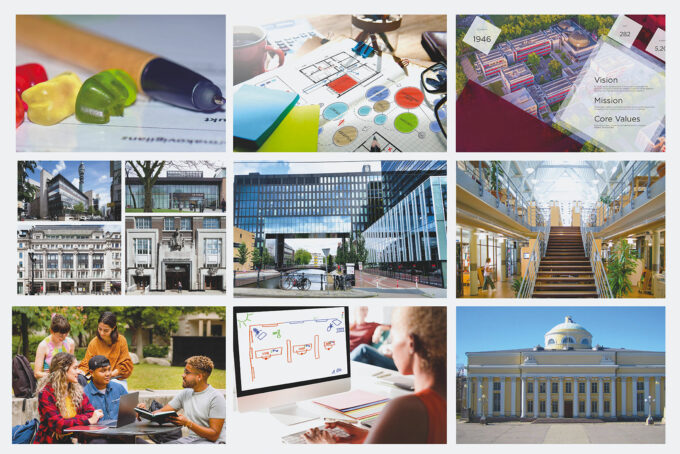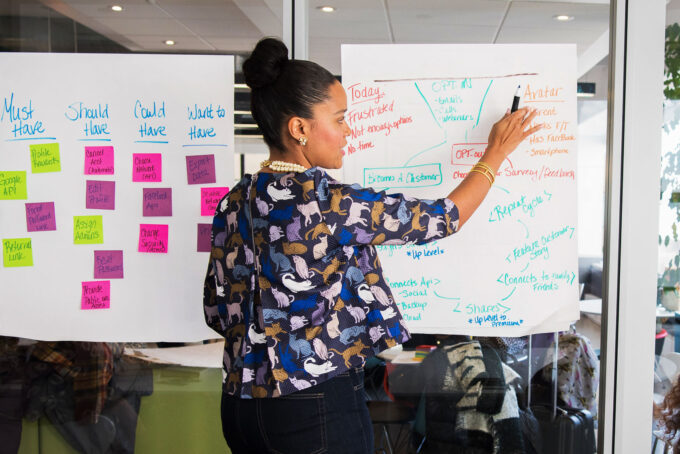
Trends 2024: Workplace Revolution Leveraging old and new Technologies
Which trends will shape library work in 2024? Generative AI, hybrid work and a skills shortage pose big challenges for libraries and other organisations – and new opportunities. Leveraging old and new technologies has the potential to renew the way patrons are served and enrich working in libraries as a whole. Learn about AI support and avatar workers as well as about SMS and decelerating trend cycles.
by Birgit Fingerle

New trends have an impact on how they offer and which services libraries and other institutions offer to their patrons. Among the trends selected because of their high relevance for libraries and other digital infrastructure facilities in 2024 are a lot of topics based on generative AI: AI revolution in the workplace, AI support and avatar workers in customer services as well as AI art. Of course hybrid work and mental health also play a major role. Perhaps more surprising are innovative ways of using the older SMS technology for customer service and decelerating trend cycles.
AI revolution in the workplace
Of course generative Artificial Intelligence (AI) has a central role among this year’s trends as work is undergoing a revolution (see trend No. 20 The AI workforce) due to generative AI requiring new skills and reshaping careers. Employers and employees are well-advised to get ready for an AI-powered future.
Though Gen AI is rapidly being incorporated into work and daily life, many employers have not yet established a generative AI policy. Additionally, the digital skills gap widens. Thus, continuous learning and a culture fostering it is vital.
Tackling skills shortage with AI
Generative AI could for instance help to tackle workforce shortages in the non-profit sector by expediting and streamlining labour-intensive internal processes. This could free up budgets and reduce stress, which are among the leading causes for vacancies.
Supporting, not replacing staff members
Companies are working on enriching in-house expert knowledge with generative AI tools. The US supermarket chain Walmart for example developed a generative AI tool called My Assistant for its employees. It supports employees in draft writing. It also provides inspiration and summarizes documents. Its aim is to help them to “work faster and more efficiently” and not to replace staff members. The global consultancy firm McKinsey implemented AI for all to offer skill for all and to let everyone profit from its productivity benefits.
How can AI be an enhancement that helps everyone to thrive in library workplaces?
Customer Service
AI Support
Another opportunity for exploiting AI’s benefits is AI support offered by AI chatbots to improve the online experience. Among the examples are the BILLIE Chatbot launched by IKEA or the Personalized Chatbot Builder Tools offered by IBM’s Watson Assistant to create helpful chatbots. How does this apply to libraries?
SMS Commerce
Seemingly opposed to all the new technologies are new shopping services based on mobile SMS applications allowing customers to browse, purchase, and pay through a text message. This reduces online barriers for consumers not familiar with mobile storefront applications. Seamless shopping services via SMS make use of chatbots that help to navigate the online shopping ecosystem. Among the retailers offering text-to-Shop Retail Services is US supermarket chain Walmart. How could libraries benefit from leveraging older technology for accessibility?
Avatar Worker
Due to the lack of skilled workers some companies count on remote workers with realistic in-store avatars for their customer service. These avatar workers are controlled by actual humans, meeting consumers’ longing for interacting with a human. Examples are: remote work cashiers, avatar-staffed convenience stores and virtual avatar workers. Could libraries benefit from metaverse avatars and remote employees?
Combatting misinformation
Organisations could fight the risk of misinformation that goes hand in hand with generative AI by implementing community-led control measures which might use AI themselves to detect and moderate disinformation. This could also ease consumer concerns about generative AI. These measures could encompass content labelling, corrective information from authority figures, content moderation and improved digital literacy.
AI Art
Many people have already experienced generative AI in artworks. As a logical consequence AI galleries, where curators are displaying notable AI artworks from prompt writers, saw the light of day. What could libraries and other institutions learn from this trend? How could they use AI for more innovative services?
Hybrid and flexible work is here to stay
The demand for continued hybrid and remote work arrangements continues. As more offices adopt a hybrid model more flexibility is needed than before the pandemic, a trend called “Agile Workplace” in Trendhunter’s 2024 Trend Report. The agile workplace comes with special challenges that organizations have to solve and is an opportunity to think about how they could benefit from these changes. It leads for instance to new evolving modular hybrid work layouts, hybrid office management platforms, hybrid work scheduling apps and hybrid work-focused mapping tools.
Mental Health
According to 2024 Higher Education Trend Watch more attention to well-being and mental health is one of the top trends in higher education. Many higher education institutions have increased support and funding for mental health for its employees and its students. Furthermore, many institutions have increased their outreach efforts, raising awareness about mental health and teaching how to distinguish “normal stress” from a mental health crisis. Of particular importance: many organisations are creating a genuine culture of understanding for mental health issues, treating them as important as physical health issues. However, the mental health crisis is a topic important in all kinds of organisations and all parts of society.
Well ambition and idyllic idleness
As more people are seeking a healthier balance, wellbeing and ambition cease to be opposites, leading to the trend called “Well ambition”. Organisations can support this development, by on the one hand emphasizing the importance of rest and downtime and on the other hand offering support for mental health to its employees.
This goes hand in hand with Idyllic idleness which means making time for moments of boredom and downtime. Although this can be seen as a necessity for leading a healthy life, it somehow seems to have been lost during the last decades while overwork and being busy were seen as a kind of status symbol. Now, doing nothing, taking enough time to sleep and being present in the here and now seem to be getting more appreciation.
Fighting loneliness – fostering belonging
On a global level seventy-one percent of people see loneliness as an epidemic and 66% feel a lack of community. Organisations might see this as an opportunity to offer shared experiences that promote connection. Bringing people together and forging community bonds in mass collective experiences is a mean for fulfilling this yearning for connection and belonging where organisations can tap in. Connecting people and serving their community is seen as a big potential for brands, see trend prosocial effervescence. IKEA demonstrated one possible way of doing this, acting as a facilitator when it brought people together in its store hosting nighttime raves during Milan Design Week in 2023. It provided the venue and the occasion; the people participating did the rest. Another retailer, department store Selfridges is about to launch a permanent event space on its fourth floor. How could libraries further foster community bonds?
Decelerating hype cycles
Remarkably, the Future 100: 2024 trend report by VML (formerly Wunderman Thompson) forecasts a slowdown of trend cycles, because of fast-moving trend cycles creating fatigue. This means benefits from a sustainability point of view and fits well with the above mentioned mental health issues and with consumers expressing the wish to slow down the pace of their life (73% according to global research from Ipsos).
This might also interest you:
- Accenture: Life Trends 2024
- Accenture: Technology Vision 2024
- Euromonitor: International 2024 Consumer Trends
- FDM Group: 9 Workplace trends for 2024
- Forbes: Key Workplace Trends You Need To Know For 2024
- Gallup: 6 Workplace Trends Leaders Should Watch in 2024
- Gartner: 9 Future of Work Trends for 2024
- GWI.: Connecting the dots: Discover the consumer trends taking over 2024
- Technologymagazine: Top 10: Technology trends for 2024> /li>
- Trendhunter: 2024 Trend Report
- Trendwatching.com: 2024 Trend Check
- VML: The Future 100: 2024
- ZBW Mediatalk: Digital Trends 2023: Bridging the Gaps Between Home Office Autonomy and Collaboration, Mental Wellbeing and Skills Shortage
Birgit Fingerle holds a diploma in economics and business administration and works at ZBW, among others, in the fields innovation management, open innovation, open science and currently in particular with the “Open Economics Guide”. Birgit Fingerle can also be found on LinkedIn.
Portrait, photographer: Northerncards©
View Comments

Open Science Monitoring: Openness as a Natural Part of Good Research Practices in Finland
A lot has happened in Finland over the past few years in relation to Open Science....



